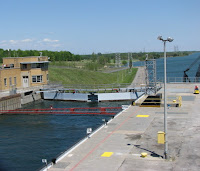The distant sound of the heavy clop of horses’ hoofs grew louder and louder, then faded in a soft rhythmic beat. Buggy wheels crunched the loose stones on the road. Inside the buggy’s black box, I could see a man with the reigns in his hand. Beside him sat a woman wearing a traditional bonnet. The children seated in the rear turned in curiosity; but man and woman gazed straight ahead as if to not acknowledge our buggy – a blindingly bright chrome Prevost coach. The buggies were common place in Macton, our motor home was not.
The rural community of Macton, Ontario lies north of the Canadian city of Kitchener. Although Kitchener happened to be our destination, our arrival late in the day meant Ed and I went looking for a place to boondock for the night. Our Roadtrek factory tour would wait until the next morning. While considering one church parking lot, I met Cleason. He parked his heavy duty black truck and flatbed rig parallel to our coach. Was he looking for an overnight parking spot too? Surely not so I decided to ask him for suggestions on where we could boondock for a night.
He quickly assessed the current church lot. In a voice with a German accent, he said, “This lot has too much of a slope. You could park at my farm.” The unexpected hospitality of this stranger surprised me. When he started to ramble off directions, my eyes glazed over with all the turns here and there. He would have lead the way but he still had some work to do, “I’ve got to get that bulldozer over there on my truck and haul it a ways.”
“Your house sounds a bit of a distance away,” Ed interjected. “How about a closer, quiet church lot in the country?”
Cleason beamed, “I have just the place. You’ll like St. Joseph’s Church in Macton. You might even see a few Mennonite buggies or two.” For this place, Cleason wrote the directions on a page of our spiral bound notebook kept handy just for these occasions.
Cleason’s directions took us through a grid of right turns on rural two lane roads through Ontario’s Mennonite Country. We passed huge farm houses, planted fields, meticulously maintained barns, lines of family laundry waving in the breeze, red tulip gardens in blossom, and some buggies.
“The Church will be on the left, you can’t miss it,” I read the last line of Cleason’s directions. He added his cell phone number just in case we did miss it.
St. James Roman Catholic Church stands in the Township of Peel in Wellington County on Highway 86. Erected in 1878 and now designated as a Peel Historic Site, St. James Church remains a solid remnant of the early Irish settlers – The Connollys, O’Neils, McCardles, O’Donnells. Grave stones in the Church Cemetery remember these people as beloved wife, children called to heaven, and devoted husband. Some of the stones, too old to stand, lay flat on a concrete slab in a mosaic of sayings like this:
“Sleep on sweet babe and take thy rest. God called thee home. He thought it best.”
Some of the markers pre-date the Church, going back to 1876. Newer markers remember the passing of parishioners from a more current time. All set in the shadow of a big white cross.
The doors to St. James Church were locked. I stood stretching on the tips of my toes to peek through a window at the entrance. Inside were a traditional altar, crucifix, saintly statues, and rows of pews. A sign outside indicated that priests only offer an 11 AM Sunday Mass here from June to September to serve the diminishing Roman Catholic population. A much different religious population seemed evident now. They were the Mennonites with their horses, buggies, and traditional dress.
I waited until dark to hang our coach’s privacy curtains across the front windows. I watched from a distance the coming and goings of the buggies along the wide gravel bream of Route 86.
We had only one visitor that evening. Cleason stopped by to be sure we found his recommended destination. He’d never been inside a Prevost. And, from one of the seats, he watched the movement of buggies saying, “There goes my Dad’s bother….Oh, that was my Cousin…Those folks with the steel wheels are part of the David Martin sect…”
He paused to take a call on his cell phone from his brother. When he ended the call he laughed, “You couldn’t understand a word I said.” Nope, he’d been speaking in his native German dialect. We laughed too. Cleason may have a truck and dress in t-shirt and jeans, but he’s still connected to the old way, a way he knew two travelers would enjoy if only from the view of a coach window in the parking lot of a historic church in rural Macton, Ontario.























